
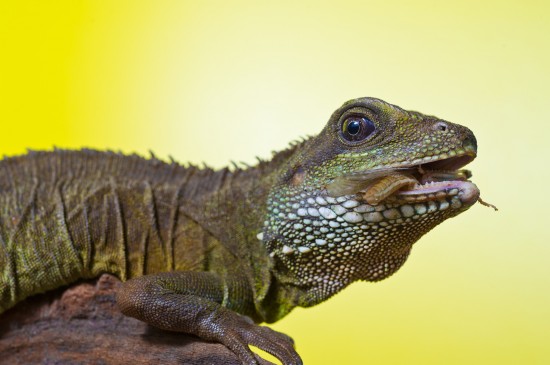
The Green Water Dragon (Physignathus cocincinus) is amongst the more commonly available species of pet lizard. It is a member of the Agamidae family of lizards, and originates from areas of Southeast Asia including Thailand and China, where it naturally inhabits densely vegetated forests. They are not aggressive – fights are rare, although males may take up elevated basking positions as part of territorial displays in order to signify their dominance. As their name suggests, they spend a significant proportion of their time in and around water. They will select a branch or other basking site positioned above a river from which they may plunge into the water if danger threatens. In captivity, the water dragon is considered a medium-sized lizard, with adults reaching an overall length of up to 3 feet including the tail. Healthy individuals have a bright emerald green body colour and a pale yellow hue to the underbelly and chest. Adult males may be distinguished from females by their larger body size, distinctive dorsal crests and pink pigmentation on the chin and throat. They also exhibit enlarged fermoral pores on the insides of the hindlegs. Females are smaller and of lighter build, with pale blue or turquoise pigmentation to the chin and throat. Their attractive appearance, coupled with a docile temperament and tolerance for handling and human interaction has made the water dragon one of the most popular pet lizards.
When housing water dragons in captivity, it is important to consider their natural habitats and endeavour to replicate these environmental conditions as accurately as possible in order to provide the best possible accommodation and minimise the occurrence of environment-related diseases, disorders and stereotypies. Wild water dragons spend the majority of their time either perched in trees and foliage or submerged in water, and so it is essential that they be housed in large arboreal-style vivariums with plenty of vertical space for climbing. It should also be noted that wild water dragons are native to the tropics, and being endotherms are reliant on an external source of heat in order to raise the body temperature to within optimum levels for their metabolic processes such as digestion and growth to occur. In order to maintain optimum temperature ranges, specific electrical equipment will need to be installed that allow the lizard to thermo-regulate. A large, deep pool should be provided that must be deep enough to prevent the dragon injuring itself should it jump into it from above, and the water treated using a specialist additive designed for reptiles to remove harmful chlorides and fluoride which may otherwise accumulate in the tissues and cause illness, Some keepers even chose to furnish their water dragons’ vivaria with built-in ponds complete with waterfalls and filters to remove waste build-up.
Environmental enrichment for water dragons comprises the provision of appropriate basking sites, areas for climbing and exercise and a secure hiding place where the animal can rest without being disturbed. These requirements are usually achieved through the decoration of the vivarium in such a way that it replicates the animal’s natural habitat, thus promoting the expression of natural behaviours and preventing the development of stereotypies. The strategic placement of sturdy branches and shelves provide areas for perching, climbing and basking, and the addition of generous coverings of real or fake plants on the floor and on the walls provide cover which help the dragon to feel more secure. A secure hide can be in the form of a 3 sided wooden box positioned in a top corner at the back of the vivarium, with the open front screened with plants.
When formulating a reptiles’ diet it is important to consider the species’ natural diet in the wild and associated behaviours. Water dragons are primarily insectivores and should be fed a varied diet of commercially farmed live insects, which are released into their enclosure to allow the dragon to perform its natural feeding behaviour of hunting and killing its prey.
The staple daily diet should be based on appropriately sized brown or black crickets and locusts which must be gut-loaded before feeding with vegetables and bran. Regular sized and giant mealworms may also be offered and provide an excellent source of protein and can easily be bred in colonies at home to keep costs down. Waxworms – the white, grub-like larvae of the wax moth - are full of protein and a particular favourite of water dragons but they can be quite fattening, and should be fed as treats to healthy dragons, or used to improve the weight and condition of sick or anorexic individuals. Silkworms are expensive but invaluable for debilitated or unthrifty dragons, as they are soft-bodied, easily digestible, palatable and highly nutritious. All livefoods should be dusted prior to feeding with appropriate calcium and vitamin and mineral supplements, although care must be taken to ensure the manufacturer’s recommended dosages are adhered to carefully in order to prevent nutritional deficiencies or excesses from occurring. Adult dragons may be offered defrosted small mice or rat pups once a week as a protein-rich addition to the normal insectivorous diet, and these may be especially valuable for gravid females carrying eggs. As with all reptiles, it is essential to monitor the body condition carefully through observation and frequent weighings using kitchen scales, and adjust the diet accordingly if the individual is found to be obese or underweight.
Nutritional Secondary Hyperparathyroidism (NSHP), also known simply as Metabolic Bone Disease (MBD) is the most commonly observed disorder seen in captive reptiles of all species. It is a form of nutritional osteodystrophy, where the bones become increasingly thin, brittle and rubbery as calcified bone matrix is dissolved in order to increase the levels of calcium in the blood. It is typically caused by a lack of dietary calcium and vitamin D3, and underexposure to full spectrum UVB lighting, but may also be induced by excessive levels of dietary phosphorus. Clinical symptoms include lethargy and depression, gastrointestinal ‘bloating’ due to inhibited digestion and poor growth and loss of condition. Deformation and deviation of the skeleton particularly of the limbs, spine and lower mandible, and multiple fractures in the limbs and painful swelling of the joints leading to lameness also feature in the later stages of the disease. Occasionally tremors and seizure-like behaviours may be observed as a result of hypocalcaemia, and pressure from deformations in the spine that interfere with the conduction of nervous impulses.Diagnosis is confirmed via the use of radiographs, which will typically show a significant decrease in bone density and so an increase in skeletal radiolucency, and may also be of use in identifying severe fractures that require surgical repair. Treatment and prognosis depends largely on the stage of progression of the disease. In very severe cases where the spine is fractured and the spinal column severed, the animal becomes paralysed and humane euthanasia is the only option. In the majority of cases, improvement of the calcium content of the diet and additional supplementation with either an oral calcium and D3 treatment, or intracoelomic injections with an appropriate calcium solution is the principle treatment. The husbandry of the patient should also be reviewed and the importance of correct UVB lighting and dusting of feeder insects emphasised to the owner. Additional supportive therapy includes rehydration with a vitamin and electrolyte supplement, and recovery in a simplistic hospital vivarium with no extraneous décor that the animal may fall from and so inflict further trauma to its recovering bones. An animal that is severely debilitated from one illness will often become susceptible to secondary bacterial and parasitic infections, and so anthelmintics and antibiotics may be administered alongside the primary treatment. A noticeable improvement in condition and bone density should be seen within 4 – 6 weeks of treatment with oral or injectable calcium.
Nose-rub (known as self-inflicted rostral trauma in veterinary terms) and associated periodontal infections such as stomatitis are the result of the animals’ performance of a stereotypy known as Interaction with Transparent Boundaries (ITB). Green water dragons are notorious for self-inflicted injuries to the snout and rostral areas as a result of performing this abnormal behaviour, characterised by the lizard repeatedly running into or rubbing its face against the glass doors of their vivaria. Although there is currently no research to determine the exact mechanism that drives the behaviour, it is noted that stereotypies are an important indicator of poor welfare and so the animals’ housing and husbandry must be evaluated for appropriateness on presentation of a dragon with such injuries. It has been suggested in various veterinary texts and journals that clearly marking the glass doors with dark tape will help to prevent ITB, but there is no research to prove or disprove this theory. Most dragons show at least a minor degree of damage to the snout, but in very bad cases whole sections of the upper and lower mandible may have been broken off, leaving the insides of the mouth exposed. In such cases infectious stomatitis (Mouth Rot) quickly sets in. Clinical signs include a distinctive foul-smelling and mucoid exudate, often resembling cottage cheese, along the inside of the lips and on the roof of the mouth, and in advanced cases infection of the mandible bone will cause the jaw itself to become crumbly and the teeth to fall out. The animal will lose condition rapidly as a result of its reluctance to feed. Diagnosis is via clinical signs and bacterial culture of swabs to confirm the presence of either Pseudomonas bacteria or Aeromonas or both. Principle treatment of stomatitis involves stabilisation of extremely weak animals via fluids and glucose, followed by symptomatic treatment of the infection itself. Injectable antibiotics as well as topical application of a dilute povidone-iodine solution to the damaged tissue will often clear up the majority of visible symptoms within a fortnight, although antibiotic eradication may require longer. Often there is permanent disfigurement.
Dystocia is a considerable issue in female water dragons that are at extremes of body condition, i.e., anorexic or severely obese. Symptoms of dystocia or ‘egg-binding’ include lethargy, depression and anorexia. The female will typically show signs of discomfort as the eggs are gently palpated through the abdominal wall. Treatment consists of intramuscular oxytocin injections and lubricating and removing any eggs present at the cloaca. If no further eggs are passed after 24 hours, surgery may be necessary to remove the remaining eggs. The ovaries are often removed as well to prevent future reoccurrences.
The majority of diseases and disorders can be prevented through the provision of good husbandry and hygiene. The attentive owner will take measures to ensure their animals are housed correctly and their nutritional requirements are met. Any waste materials and faeces should be incinerated to prevent the spread of Salmonella infections and the hands washed after handling of the animals. A veterinarian should be consulted if a reptile’s appearance or behaviour gives cause for concern.
The green water dragon makes a good pet reptile provided its environmental, nutritional and behavioural needs are considered and made available in captivity. A dragon housed in a suitable arboreal vivarium with appropriate heating and extensive environmental enrichment, and fed a diet of supplement-dusted live insects will normally show all the signs of optimum health. However, owners should be vigilant for the symptoms of common disorders such as NSHP and rostral damage, and seek veterinary attention if they suspect their pet is unwell. Good hygiene and husbandry are key to preventing illness and behavioural abnormalities from developing.
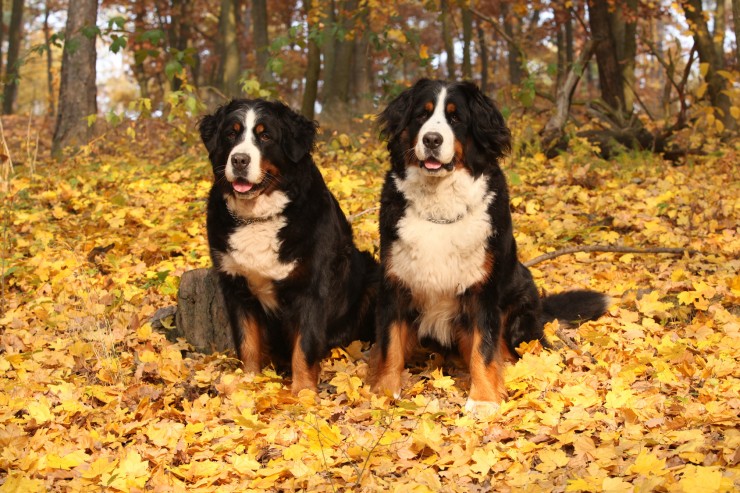 Dogs Copy Other Dog’s Behaviour - Good And Bad!
Dogs Copy Other D
Dogs Copy Other Dog’s Behaviour - Good And Bad!
Dogs Copy Other D
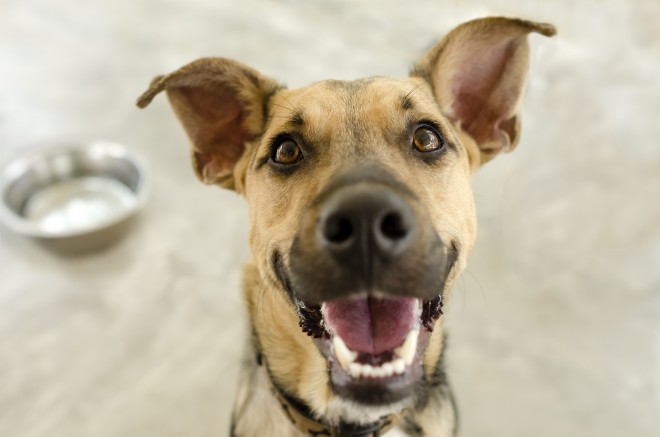 Reasons Why A Dog Might Bite
Reasons Why A Dog
Reasons Why A Dog Might Bite
Reasons Why A Dog
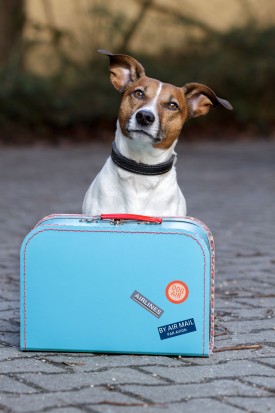 Holiday Time - Kennels Or Dog Sitter
Holiday Time - Ke
Holiday Time - Kennels Or Dog Sitter
Holiday Time - Ke
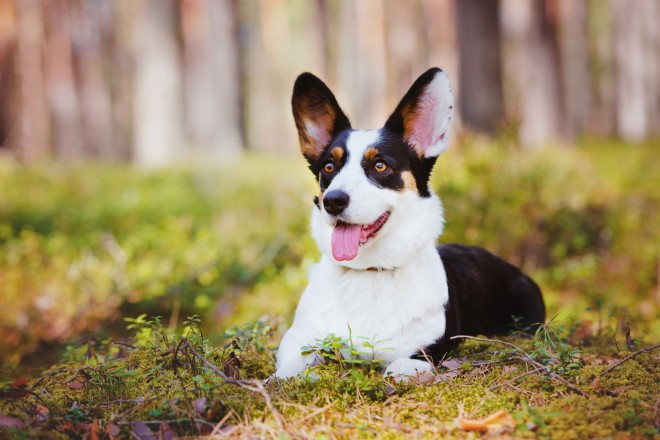 Cardigan Welsh Corgi Hereditary Health And Health Testing
Cardigan Welsh Co
Cardigan Welsh Corgi Hereditary Health And Health Testing
Cardigan Welsh Co
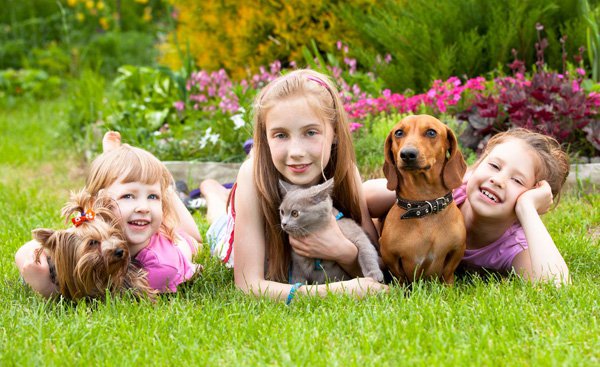 Super Food for Dogs to Achieve Good Health
Super Food for Dogs to Achieve Good Health
Spe
Super Food for Dogs to Achieve Good Health
Super Food for Dogs to Achieve Good Health
Spe
Copyright © 2005-2016 Pet Information All Rights Reserved
Contact us: www162date@outlook.com